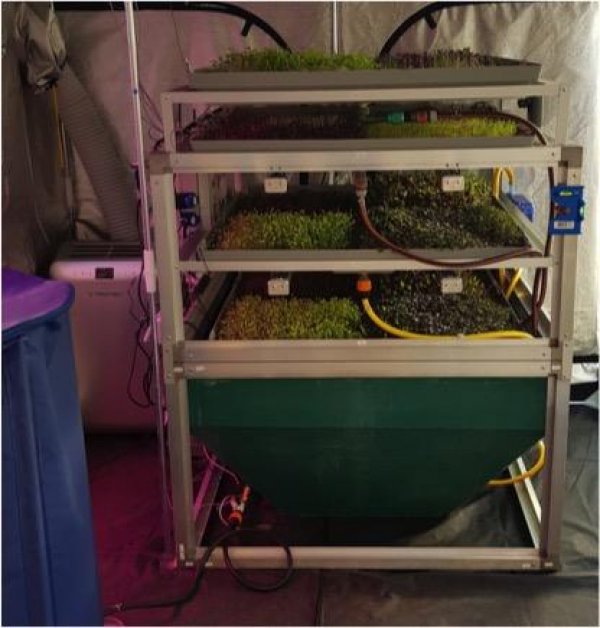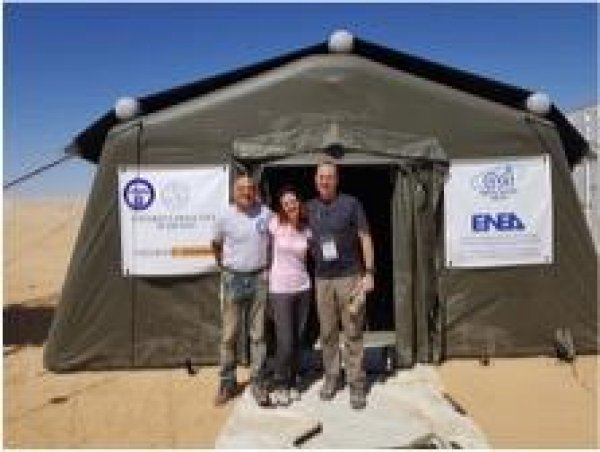Exhibitors 2018
- HOME AUTOMATION
- ROBOTICS
- YOUNG MAKERS (< 18)
- OPEN SOURCE
- 3D PRINTING
- DRONES
- EDUCATION
- FABRICATION
- HACKS
- NEW MANUFACTURING
- SCIENCE
- ENERGY & SUSTAINABILITY
- ART
- INTERNET OF THINGS
- MUSIC & SOUND
- RECYCLING & UPCYCLING
- KIDS & EDUCATION
- ARTISANS & NEW CRAFT
- CULTURAL HERITAGE
- GAMES
- WELLNESS & HEALTHCARE
- FASHION & WEARABLES
- FOOD & AGRICULTURE
- BIOLOGY
- 3D SCANNING
- AEROSPACE
- STEAM PUNK
- ARTIFICIAL INTELLIGENCE
- ARDUINO
- CROWDFUNDING
HorteXtreme
In February 2018, the Austrian Space Forum, in cooperation with the Oman Astronomical Society have conducted an integrated Mars analog field simulation in the Dhofar region, Sultanate of Oman, named AMADEE-18. Directed by a Mission Support Center in Austria, a small field crew have performed experiments in different research fields, paving the way to future human Mars missions.
The Italian Space Agency, together with ENEA and the University of Milan, proposed, in the Bioregenerative Life Support Systems field, the experiment “Hortextreme”, which aims to develop novel cultivation methods dedicated to future Mars exploration missions.
We have focused our project on the production of microgreens that are leafy vegetables harvested as seedlings 7-15 days after germination, highly acceptable by consumers as Ready To Eat (RTE) food because tender, tasty, and visually attractive. They are promoted by scientific reports as an highly nutritious and healthy food product, being an eccellent source of vitamins and antioxidants in concentrations from 4 to 40 times higher than in mature plants. Microgreens are best suited for the production of leafy vegetables in that they are: i) short in height (7-12 cm), adaptable to multitier cultivation racks; ii) fast growing (7-21 days); iii) performing well under low light intensity and at a high plant density; iv) high added-value product because fresh, clean, nutritious, and pesticide free; v) amenable to quality improvement by environmental control and led light. The microgreen species Mustard Ruby Streaks (Brassica Juncea L.), Red Cabbage (Brassica Oleracea var. capitata), Radish Red Rambo (Raphanus sativus) Amaranth Red Army (Amaranthus cruentus) were selected for their high content of vitamins, carotenoids, anthocyanins and organoleptic characteristics (sowseeds.co.uk).
Thanks to the environmental conditions of the Kepler Station in Oman desert, the experimental site have been useful for evolving the knowledge on human behavior in a restricted and extreme environment, mimicking life conditions typical of spaceflight or orbiting stations. The challenge of this proposal was to realize a portable fully automated hydroponic system equipped with LED light in a climatically controlled inflatable plant growth facility, designed by means of the TRNSYS computer code, for the production of high quality microgreens to study the effects of two LED light photoperiod regimes on the growth, morphology and nutritional characteristics and also to support the diet of the crew members of the mission. In the facility assembly, robust commercial components have been privileged in order to minimize the total cost of the project and to guarantee, at the same time , ease in handling, high reliability and availability of spare parts. All the facilities, the scientific instruments and the experimental procedures were selected to reduce the number of man/hours necessary for handling, installation and testing. For biometric measurements portable lightweight multiparameter scientific instruments were selected that can perform real-time non destructive analysis. It is clear that atmospheric and environmental conditions of the test site are far from being similar to those of Mars habitat. Nevertheless, we firmly believe that the technology tested will help to reduce the resources used, reduced need for consumable resupply, enhanced diet (fresh highly nutritious food, with best organoleptic characteristic) gained psychological/physiological benefits of having plants integrated in the habitat.
The Italian Space Agency, together with ENEA and the University of Milan, proposed, in the Bioregenerative Life Support Systems field, the experiment “Hortextreme”, which aims to develop novel cultivation methods dedicated to future Mars exploration missions.
We have focused our project on the production of microgreens that are leafy vegetables harvested as seedlings 7-15 days after germination, highly acceptable by consumers as Ready To Eat (RTE) food because tender, tasty, and visually attractive. They are promoted by scientific reports as an highly nutritious and healthy food product, being an eccellent source of vitamins and antioxidants in concentrations from 4 to 40 times higher than in mature plants. Microgreens are best suited for the production of leafy vegetables in that they are: i) short in height (7-12 cm), adaptable to multitier cultivation racks; ii) fast growing (7-21 days); iii) performing well under low light intensity and at a high plant density; iv) high added-value product because fresh, clean, nutritious, and pesticide free; v) amenable to quality improvement by environmental control and led light. The microgreen species Mustard Ruby Streaks (Brassica Juncea L.), Red Cabbage (Brassica Oleracea var. capitata), Radish Red Rambo (Raphanus sativus) Amaranth Red Army (Amaranthus cruentus) were selected for their high content of vitamins, carotenoids, anthocyanins and organoleptic characteristics (sowseeds.co.uk).
Thanks to the environmental conditions of the Kepler Station in Oman desert, the experimental site have been useful for evolving the knowledge on human behavior in a restricted and extreme environment, mimicking life conditions typical of spaceflight or orbiting stations. The challenge of this proposal was to realize a portable fully automated hydroponic system equipped with LED light in a climatically controlled inflatable plant growth facility, designed by means of the TRNSYS computer code, for the production of high quality microgreens to study the effects of two LED light photoperiod regimes on the growth, morphology and nutritional characteristics and also to support the diet of the crew members of the mission. In the facility assembly, robust commercial components have been privileged in order to minimize the total cost of the project and to guarantee, at the same time , ease in handling, high reliability and availability of spare parts. All the facilities, the scientific instruments and the experimental procedures were selected to reduce the number of man/hours necessary for handling, installation and testing. For biometric measurements portable lightweight multiparameter scientific instruments were selected that can perform real-time non destructive analysis. It is clear that atmospheric and environmental conditions of the test site are far from being similar to those of Mars habitat. Nevertheless, we firmly believe that the technology tested will help to reduce the resources used, reduced need for consumable resupply, enhanced diet (fresh highly nutritious food, with best organoleptic characteristic) gained psychological/physiological benefits of having plants integrated in the habitat.
Italy
Luca Nardi, Sara Piccirillo, Francesco Cavaliere, Giulio Metelli, Giuseppe Corallo, Marco Potenza, Gabriele Mascetti, Eugenio Benvenuto
Luca Nardi, PhD, is a permanent staff scientist at the Biotechnology Laboratory, ENEA Division Biotechnology and Agroindustry. Agronomist, he is specialized in Tropical and Subtropical Agrobiotechnology. More than fifteen years' experience in cytogenetics, molecular biology, flow cytometry, in vitro plant cell culture, statistics and bioinformatics. Author of numerous publications on international biotechnology journals. In charge of the phytotron facilities and the experimental containment greenhouse BSL2 (Biosafety Level 2). The greenhouse is endowed with a "solar cooling" system to reduce energy input and with improved ICT automation and controls. In these facilities he has established rules of Good Agricultural Practices (GAP) and Good Laboratory Practices (GLP) for high-quality horticultural produce through soilless hydro-aeroponics and LED lighting.
E29 (pav. 4)





















































































